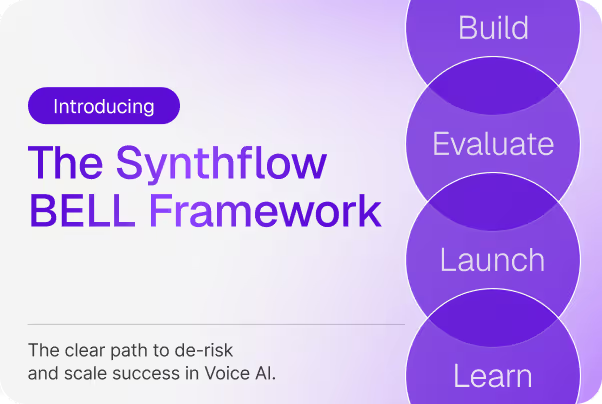Product
Why Synthflow Built Its Own Telephony — and How It Changes the Game for Voice AI

Table of Contents

If you’ve ever spoken to a voice assistant that sounded slow or robotic, you’ve experienced the hidden challenge behind most Voice AI systems: the phone connection itself.
Every AI conversation starts with telephony — the layer that lets your voice agent make and receive calls, show caller ID, and carry audio back and forth in real time. That layer decides how clear the sound is, how quickly the AI responds, and how reliable every call feels.
Other Voice AI providers rent that layer from third-party vendors like Twilio or Vonage.
At Synthflow, we chose a harder path — we built it ourselves.
What “Owning Telephony” Actually Means
Telephony is the bridge between your AI and the global phone network. It covers everything from phone numbers and routing to the media servers that transmit audio.
Synthflow runs its own enterprise-grade communications network, managed by our in-house telephony & engineering team.
Instead of relying on vendors like Twilio or Vonage, we’ve built and operate the core systems — called Session Border Controllers (SBCs) and media servers — that handle call routing, security, and audio relaying.
Because this network is fully ours, we control every aspect of performance, from how traffic flows to how quickly issues are resolved.
That gives us direct control over:
- Routing and capacity
- Change windows and incident response
- Codec tuning
- Authentication methods
- Regional deployment options
Bottom line: Owning the stack means we can guarantee performance and reliability at a level rented systems can’t match.
Why It Matters for Performance
Every phone call travels through a physical network of servers and carriers. When Voice AI platforms rely on third-party vendors, those calls often take long, fixed routes — sometimes across continents — before reaching your customer. Each extra hop adds delay, distortion, and risk of dropped audio.
With Synthflow’s regional Points of Presence (PoPs), we place infrastructure close to where your calls originate so data doesn’t have to travel halfway around the world. In a recent LATAM deployment, that proximity reduced round-trip latency from 191 ms to 99 ms — a 48 % improvement in responsiveness and call clarity.
Shorter paths deliver measurable gains:
- Faster responses (< 100 ms RTT for regional traffic) so conversations flow naturally
- Higher clarity (MOS > 4.2 and premium R-Factor) with fewer artifacts or dropouts
- Stable performance even during heavy, bursty traffic
In practice, this means AI agents that sound human — no awkward pauses, no clipped words, just seamless conversation.
Seamless Integration with Your Environment
Owning our own telephony doesn’t mean you have to change yours. Many enterprise Voice AI platforms lock you into their vendor or force you to replace your existing phone systems. Synthflow doesn’t. Our infrastructure is designed to plug into what you already use — so you keep your carriers, PBX, or Twilio setup, while gaining the performance and reliability of our network.
We interconnect easily with:
- Enterprise PBX and SIP systems like Asterisk, Cisco, Avaya, Genesys, and others
- Carrier SIP trunks, if you prefer a bring-your-own-carrier model
- Existing Twilio accounts, for teams already standardized on that infrastructure
You can start small — for example, by using a Synthflow test number to validate call flows — and then scale up to Twilio or full SIP trunking as you grow.
It’s integration without disruption: the reliability of a purpose-built telephony stack, combined with the flexibility to keep the systems and carriers you already trust.
Optimized for AI Workloads, Not Just Voice
Most telecom systems were designed for people talking to people. Voice AI works differently — it needs to listen, think, and respond in real time. That requires far lower latency, faster data transfer, and tighter coordination between systems than traditional telephony can deliver.
Synthflow’s infrastructure is purpose-built for AI, tuned for sub-second response and large-scale automation.
That means:
- Low-latency streaming between the speech recognition, language model, and voice synthesis layers — so AI agents can respond naturally, without robotic pauses.
- Massive concurrency, supporting thousands of simultaneous calls without audio degradation.
- Private backbone routing that keeps connections stable and jitter-free across regions.
- Secure data handling with full encryption and controlled access for compliance.
This is carrier-grade infrastructure, re-engineered for the precision and speed that real-time AI conversations demand.
Engineered for Enterprise Reliability
When your business runs on live phone conversations, reliability isn’t a nice-to-have — it’s the difference between smooth operations and missed opportunities.
Because Synthflow manages routing, capacity, and uptime entirely in-house, our engineers can respond to issues instantly, without waiting on external vendors.
Our network is designed to handle sudden surges in concurrent calls — known as burst traffic — while keeping latency and call quality steady. Every component is built with redundancy and real-time monitoring, backed by a 99.99% uptime SLA.
And because reliability should never be a black box, we give customers full visibility into performance — clear metrics, transparent monitoring, and the same diagnostic tools we use internally.
It’s infrastructure you can depend on — and reliability you can prove.
The Business Impact
For enterprise contact centers, reliability isn’t just technical — it’s financial. Every millisecond of delay adds friction to customer conversations. Every drop in audio quality chips away at trust. At scale, these small interruptions turn into real costs: longer handle times, frustrated customers, and lost conversions.
By owning its telephony infrastructure, Synthflow gives enterprises control over every variable that affects performance. Rather than relying on third-party vendor networks, our customers run on a system designed to deliver predictable, measurable outcomes — at any volume, in any region.
That control translates into tangible results:
- Predictable performance — sub-100 ms round-trip latency and MOS > 4.2 for consistently natural, human-sounding conversations.
- Deployment flexibility — regional Points of Presence (PoPs) positioned wherever your operations demand, reducing distance and delay.
- Compliance confidence — full visibility into data flow and encryption, built to meet SOC 2, HIPAA, and GDPR standards.
- Vendor independence — no lock-in, no reliance on external networks, and complete control over uptime and routing.
The outcome is simple but powerful: faster calls, clearer conversations, and an infrastructure foundation enterprises can truly rely on — one that protects both customer experience and operational efficiency.
The Bottom Line
Most Voice AI platforms sound similar on the surface — but beneath the demo lies a critical dependency: almost all of them rent their telephony. That means their performance, call quality, and uptime are ultimately limited by someone else’s infrastructure.
We’re proud to be the only Voice AI company that operates a fully owned, enterprise-grade communications stack — complete with our own Session Border Controllers (SBCs), media servers, and regional points of presence.
That ownership gives us something no one else can offer: total control over how calls connect, how fast they respond, and how consistently they perform.
For enterprises, that translates into measurable outcomes — faster resolution times, lower operating costs, and a level of reliability that turns Voice AI from an experiment into part of the mission-critical stack.
See what full-stack Voice AI looks like when every layer — from telephony to AI — is built for enterprise scale. Schedule a demo now to hear the difference yourself.


.avif)
